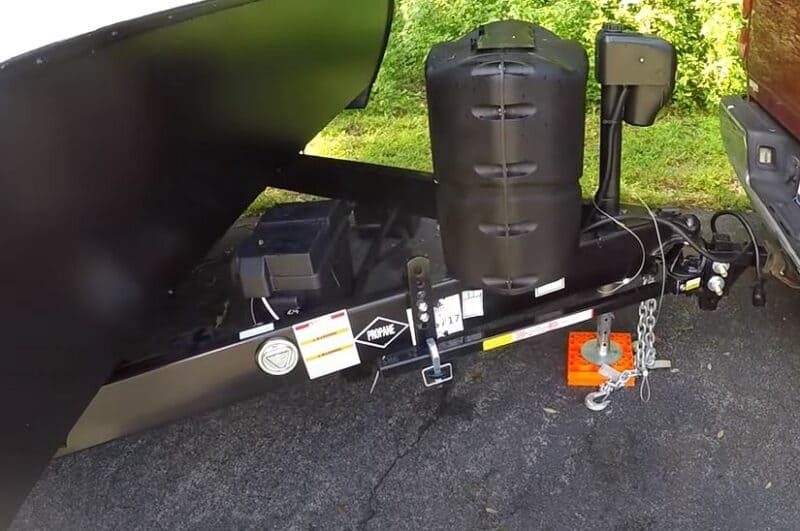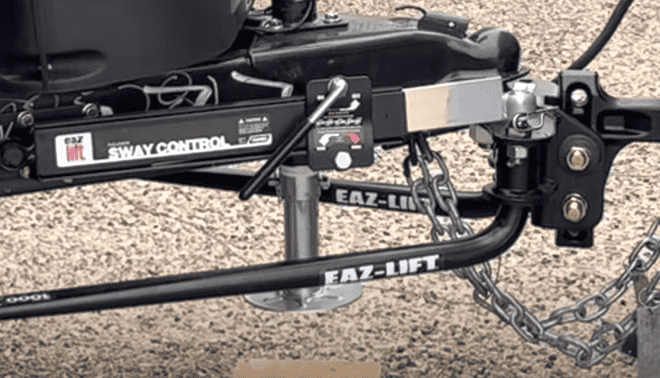Weight distribution is not the same thing as sway control.
Actually, let me rephrase that, because it’s not 100% accurate.
- The primary purpose of a weight-distribution hitch (also known as a load-leveling or equalization hitch) is to level the truck-and-trailer combination and restore some of the weight lost to the tow vehicle’s front axle.
- The primary purpose of sway control is to reduce and damp any side-to-side oscillations while driving, particularly at highway speeds.
Somewhat confusingly, a trailer with proper weight distribution will naturally tend to sway and bounce less. This is the primary reason we have minimum tongue/pin weights, after all. But this is where, unfortunately, the English language has failed us, and this sloppy use of the phrase “weight distribution” has called all manner of confusion.
So let’s back up – no pun intended – and review the basic concepts. After that, we will break down the difference between sway control and weight distribution technologies. Not all hitches re-distribute weight; not all have sway control. But there is a gray overlap between them.
What Is a Weight Distribution Hitch, and How Is It Different than Sway Control?
A weight distribution hitch apportions the weight of your tow vehicle and trailer across all axles. In particular, it restores some of the weight lost to the tow vehicle’s front axle. That’s the steering axle, so proper weight is important! That’s also where most of your braking happens.

A weight-distribution hitch does not magically add or take away pounds. Instead, it lightens the rear axle of the tow vehicle and transfers most of that weight to the front axle of the tow vehicle. It also re-distributes some of the weight back onto the trailer’s axle[s].
All this physics magic is possible cause of lever-and-fulcrum effects. We won’t get into the physics in this article, but essentially, the tongue weight of an off-balance trailer pushes down on the rear end of a truck and simultaneously lifts up the front end, like a teeter-totter.
5th wheel campers do not require any kind of weight-distribution hitch. That is because the pin is located almost directly above the rear axle. There is no lever-and-fulcrum effect.
>>> READ MORE: The Big 7 Misconceptions About Weight Distribution Hitches
A weight distribution hitch does not atone for bad tongue weight distribution to start out with! In the US, we target 10-15 tongue weight for trailers and 15-25% pin weight for fifth wheels. A trailer with, say, 6% tongue weight, is improperly loaded (or badly designed), and a weight-distribution hitch is nothing more than a Band-Aid fix.
What Is Sway Control, and How Is It Different Than Weight Distribution?

Sway control stops and damps oscillations. It operates in a different plane than weight distribution: weight distribution is top-to-bottom, sway control is side-to-side.
Now, all trailers sway, especially at speeds above 45 mph. This is for many reasons. Air is a fluid, after all, and pushing two conjoined rigid bodies through a turbulent fluid at high speeds, accelerating and braking, turning corners and bouncing over potholes, is bound to generate some wonky physics.
However, the longer the trailer wheelbase and the more tongue weight it has, generally speaking, the less likely it is to sway. King pin weights of tractor trailers, for instance, may have 50%+ of their weight on the pin! But a semi-truck can easily handle 15,000 lbs on the hitch; your pickup truck can’t.
So we must resort to other means to control sway. Enter: sway control technologies. If you think of a trailer coupler or a 5th wheel king pin hitch as a pivoting link, or a ball-and-socket joint, the problem (and solution) becomes obvious. If sway is uncontrolled side-to-side motion, then what if you just added some friction?
That’s exactly what most sway control mechanisms do: they add friction. There are simple ones, and there are clever ones. Some sway control devices increase friction with turning angle, allowing for easy low-speed maneuvers. Some use chain tension, some metal-on-metal sliding, some a rubber bushing, some trunnions, some hydraulic pistons. But most hitches work by damping the oscillations through some kind of friction (a few through spring tension).
The exception are the Hensley-style weight-distribution hitches that use a linkage mechanism instead of a ball coupler as the hitch. This mechanism locks out the joint from one way only, allowing the truck to turn the trailer, but not vice versa.
>>> READ MORE: 11 Causes of Trailer Sway and How to Stop It
Friction-based sway control is not a magic bullet. Trailers can, and will, still sway. Insufficient tongue weight, strong crosswinds, turbulence from passing tractor-trailers, and speeding at WOT down a steep hill will all attempt to induce trailer sway. Sway control will diminish their effects, but it will not eliminate them entirely.
It is usually recommended to disable or remove sway control mechanisms when driving on snow, ice, off-road, or when backing up. Check your Owner’s Manual for more information.
Leave a Reply